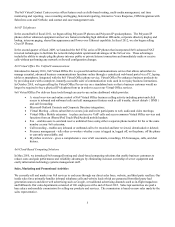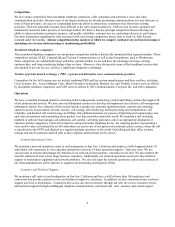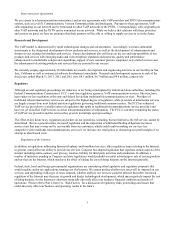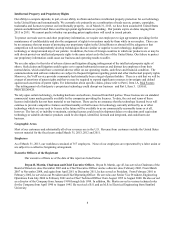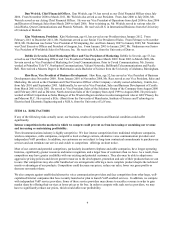8x8 2013 Annual Report Download - page 17
Download and view the complete annual report
Please find page 17 of the 2013 8x8 annual report below. You can navigate through the pages in the report by either clicking on the pages listed below, or by using the keyword search tool below to find specific information within the annual report.15
If we were found to be infringing on the intellectual property rights of any third party in these lawsuits or other claims and
proceedings that may be asserted against us in the future, we could be subject to liabilities for such infringement, which could
be material. We could also be required to refrain from using, manufacturing or selling certain products or using certain
processes, either of which could have a material adverse effect on our business and operating results. From time to time, we
have received, and may continue to receive in the future, notices of claims of infringement, misappropriation or misuse of other
parties' proprietary rights. There can be no assurance that we will prevail in these discussions and actions or that other actions
alleging infringement by us of third party patents will not be asserted or prosecuted against us. Furthermore, lawsuits like these
may require significant time and expense to defend, may divert management’s attention away from other aspects of our
operations and, upon resolution, may have a material adverse effect on our business, results of operations, financial condition
and cash flows. More information regarding the two pending suits is provided below under Part I, Item 3. “LEGAL
PROCEEDINGS.”
We license technology from third parties that we do not control and cannot be assured of retaining.
We rely upon certain technology, including hardware and software, licensed from third parties. There can be no assurance that
the technology licensed by us will continue to provide competitive features and functionality or that licenses for technology
currently utilized by us or other technology which we may seek to license in the future, will be available to us on commercially
reasonable terms or at all. The loss of, or inability to maintain, existing licenses could result in shipment delays or reductions
until equivalent technology or suitable alternative products could be developed, identified, licensed and integrated, and could
harm our business. These licenses are on standard commercial terms made generally available by the companies providing the
licenses. The cost and terms of these licenses individually are not material to our business.
Inability to protect our proprietary technology would disrupt our business.
We rely, in part, on trademark, copyright, and trade secret law to protect our intellectual property in the United States and
abroad. We seek to protect our software, documentation, and other written materials under trade secret and copyright law,
which afford only limited protection. We also rely, in part, on patent law to protect our intellectual property in the United
States and internationally. As of March 31, 2013, we had been awarded 86 United States patents and have additional United
States and foreign patent applications pending. We cannot predict whether such pending patent applications will result in
issued patents that effectively protect our intellectual property. We may not be able to protect our proprietary rights in the
United States or internationally (where effective intellectual property protection may be unavailable or limited), and
competitors may independently develop technologies that are similar or superior to our technology, duplicate our technology or
design around any patent of ours. We have, in the past, licensed and, in the future, expect to continue licensing our technology
to others, many of whom are located or may be located abroad. There are no assurances that such licensees will protect our
technology from misappropriation. Moreover, litigation may be necessary in the future to enforce our intellectual property
rights, to determine the validity and scope of the proprietary rights of others, or to defend against claims of infringement or
invalidity. Such litigation could result in substantial costs and diversion of management time and resources and could have a
material adverse effect on our business, financial condition, and operating results. Any settlement or adverse determination in
such litigation would also subject us to significant liability.
Our products must comply with industry standards, FCC regulations, state, local, country-specific and international
regulations, and changes may require us to modify existing products and/or services.
In addition to reliability and quality standards, the market acceptance of telephony over broadband IP networks is dependent
upon the adoption of industry standards so that products from multiple manufacturers are able to communicate with each other.
Our VoIP telephony products rely heavily on communication standards such as SIP, MGCP and network standards such as
TCP/IP and UDP to interoperate with other vendors' equipment. There is currently a lack of agreement among industry leaders
about which standard should be used for a particular application, and about the definition of the standards themselves. These
standards, as well as audio and video compression standards, continue to evolve. We also must comply with certain rules and
regulations of the FCC regarding electromagnetic radiation and safety standards established by Underwriters Laboratories, as
well as similar regulations and standards applicable in other countries. Standards are frequently modified or replaced. As
standards evolve, we may be required to modify our existing products or develop and support new versions of our products.
We must comply with certain federal, state and local requirements regarding how we interact with our customers, including
marketing practices, consumer protection, privacy, and billing issues, the provision of 9-1-1 emergency service and the quality
of service we provide to our customers. The failure of our products and services to comply, or delays in compliance, with
various existing and evolving standards could delay or interrupt volume production of our VoIP telephony products, subject us


